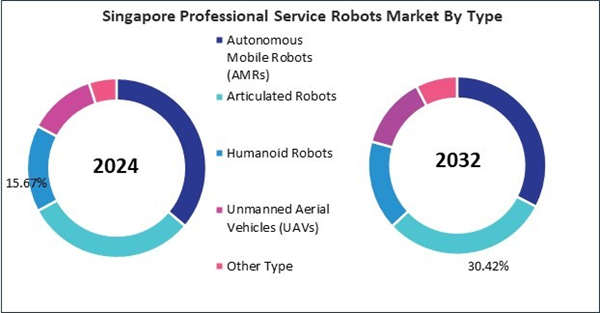The Asia Pacific Professional Service Robots Market is expected to witness market growth of 12.5% CAGR during the forecast period (2025-2032).
The China market dominated the Asia Pacific Professional Service Robots Market by country in 2024, and is expected to continue to be a dominant market till 2032; thereby, achieving a market value of $11.07 billion by 2032. Japan market is showcasing a CAGR of 11.7% during 2025-2032. Additionally, the India market would register a CAGR of 13.4% during 2025-2032.
In the construction sector, robots are used for demolition, bricklaying, painting, and 3D printing of structures. These robots improve safety, reduce construction time, and ensure better quality control. Similarly, in education and research, robotic platforms are utilized as teaching aids, simulation tools, and for performing repetitive experiments in labs, thus streamlining academic and scientific pursuits.
The adoption of professional service robots varies across regions and industries, influenced by factors such as technological infrastructure, regulatory environment, labor costs, and cultural attitudes toward automation. Developed economies in North America, Europe, and parts of Asia-Pacific have been at the forefront of robot adoption due to their advanced R&D capabilities, skilled workforce, and higher per capita incomes, which support investments in automation technologies.
The Asia Pacific region is witnessing dynamic growth in the market, propelled by rapid industrialization, increasing labor shortages, aging populations, and widespread adoption of automation across various service sectors. Countries like China, Japan, South Korea, and India are at the forefront of this trend, with robust investments in AI, robotics, and digital transformation initiatives. These robots, distinct from industrial robots, are deployed in sectors such as healthcare, logistics, hospitality, retail, and inspection and maintenance services. The region's expansive manufacturing base and growing demand for efficiency, safety, and cost optimization are amplifying the deployment of professional service robots across diverse industries.
The competitive landscape in Asia Pacific is marked by the presence of both global robotics leaders and homegrown innovators. Japanese firms such as Panasonic, SoftBank Robotics, and Omron are renowned for their advanced robotic solutions. Chinese companies like DJI, UBTECH Robotics, and ECOVACS are increasingly becoming global contenders by offering affordable, high-quality service robots tailored to domestic and export markets. South Korea’s LG and Hyundai Robotics are also enhancing their portfolios with AI-enabled service robots.
The China market dominated the Asia Pacific Professional Service Robots Market by country in 2024, and is expected to continue to be a dominant market till 2032; thereby, achieving a market value of $11.07 billion by 2032. Japan market is showcasing a CAGR of 11.7% during 2025-2032. Additionally, the India market would register a CAGR of 13.4% during 2025-2032.
In the construction sector, robots are used for demolition, bricklaying, painting, and 3D printing of structures. These robots improve safety, reduce construction time, and ensure better quality control. Similarly, in education and research, robotic platforms are utilized as teaching aids, simulation tools, and for performing repetitive experiments in labs, thus streamlining academic and scientific pursuits.
The adoption of professional service robots varies across regions and industries, influenced by factors such as technological infrastructure, regulatory environment, labor costs, and cultural attitudes toward automation. Developed economies in North America, Europe, and parts of Asia-Pacific have been at the forefront of robot adoption due to their advanced R&D capabilities, skilled workforce, and higher per capita incomes, which support investments in automation technologies.
The Asia Pacific region is witnessing dynamic growth in the market, propelled by rapid industrialization, increasing labor shortages, aging populations, and widespread adoption of automation across various service sectors. Countries like China, Japan, South Korea, and India are at the forefront of this trend, with robust investments in AI, robotics, and digital transformation initiatives. These robots, distinct from industrial robots, are deployed in sectors such as healthcare, logistics, hospitality, retail, and inspection and maintenance services. The region's expansive manufacturing base and growing demand for efficiency, safety, and cost optimization are amplifying the deployment of professional service robots across diverse industries.
The competitive landscape in Asia Pacific is marked by the presence of both global robotics leaders and homegrown innovators. Japanese firms such as Panasonic, SoftBank Robotics, and Omron are renowned for their advanced robotic solutions. Chinese companies like DJI, UBTECH Robotics, and ECOVACS are increasingly becoming global contenders by offering affordable, high-quality service robots tailored to domestic and export markets. South Korea’s LG and Hyundai Robotics are also enhancing their portfolios with AI-enabled service robots.
List of Key Companies Profiled
- Boston Dynamics (Hyundai Motor Company)
- Cyberdyne, Inc.
- Daifuku Co., Limited
- FANUC Corporation
- Gecko Robotics, Inc.
- Honda Motor Co. Ltd.
- Intuitive Surgical, Inc.
- iRobot Corporation
- Kuka AG (Midea Group Co., Ltd.)
- SoftBank Robotics Group (SoftBank Group Corporation)
Market Report Segmentation
By Type
- Autonomous Mobile Robots (AMRs)
- Articulated Robots
- Humanoid Robots
- Unmanned Aerial Vehicles (UAVs)
- Other Type
By End Use
- Healthcare & Medical
- Logistics & Transportation
- Warehousing
- Last-Mile Delivery
- Port & Cargo Operations
- Other Logistics & Transportation Type
- Defense & Security
- Hospitality
- Inspection & Maintenance
- Agriculture
- Retail
- Education
- Other End Use
By Country
- China
- Japan
- India
- South Korea
- Singapore
- Malaysia
- Rest of Asia Pacific
Table of Contents
Chapter 1. Market Scope & Methodology
Chapter 2. Market at a Glance
Chapter 3. Market Overview
Chapter 4. Competition Analysis - Global
Chapter 5. Value Chain Analysis of Professional Service Robots Market
Chapter 6. Key Customer Criteria of Professional Service Robots Market
Chapter 7. Asia Pacific Professional Service Robots Market by Type
Chapter 8. Asia Pacific Professional Service Robots Market by End Use
Chapter 9. Asia Pacific Professional Service Robots Market by Country
Chapter 10. Company Profiles
Companies Mentioned
- Boston Dynamics (Hyundai Motor Company)
- Cyberdyne, Inc.
- Daifuku Co., Limited
- FANUC Corporation
- Gecko Robotics, Inc.
- Honda Motor Co. Ltd.
- Intuitive Surgical, Inc.
- iRobot Corporation
- Kuka AG (Midea Group Co., Ltd.)
- SoftBank Robotics Group (SoftBank Group Corporation)









